Hundreds of poppies lay in front of Lynnmour Xá7elcha Elementary in North Vancouver to pay respects to soldiers as Remembrance Day approaches.
But this poppy display is different than what you'll find growing in the ground or pinned to people's chests. These poppies are made from clay, each symbolizing a Canadian soldier who died in the First World War.
Grade 4/5 teacher Paul Best has been doing the clay poppy project on and off since 2017, and this year the entire elementary school participated.
“Doing this kind of project is like an act of remembrance, and makes it more important to [students],” Best said.
Students and teachers from kindergarten to Grade 7 came together to make the ceramic poppies over a span of 20 days.
Making the clay poppies is a multi-step process. Students cut out a portion of clay with a cheese wire and rolled the clay out flat to make the shape of the poppy. The clay would then be bent in the form of a poppy and put in a kiln at more than 1,000 degrees celsius to dry them out.
After this, students put a rod in as the stem and use epoxy glue and glaze to make the poppy stand and look nice.
“This is the community doing an art installation – one that each person has been part of or one that each person is going to take away that little part afterwards,” Best said.
“A lot of our former students still talk about their poppies that they got when they were in my class years ago.”
Best came across Blood Swept Lands and Seas of Red, a famous art installation at the Tower of London, where nearly 900,000 ceramic poppies filled the moat in 2014. The installation marked 100 years since Britain’s involvement in the First World War, each poppy representing a British military fatality during the war.
After Best returned from Vimy Ridge in France in 2017, marking 100 years since the battle, a colleague suggested the idea of commemorating British Columbian solders in the same way as the famous art installation.
The project has highlighted different soldiers over the years, including those from the North Shore and Indigenous soldiers.
As Best researched throughout the years, he stumbled upon his own history – his great grandfather’s nephew, George Best, from Northern Ireland served in the First World War.
“I’m from New Zealand … and I come and find an unmarked grave near my school in Vancouver, and it happens to be my great grandfather’s nephew, how weird is that?” Best said.
The clay poppies will be on display at the elementary school’s front garden until Nov. 8, and students will take the red flowers home for ceremonies they attend over the weekend and on Remembrance Day.
Abby Luciano is the Indigenous and civic affairs reporter for the North Shore News. This reporting beat is made possible by the Local Journalism Initiative. [email protected]

